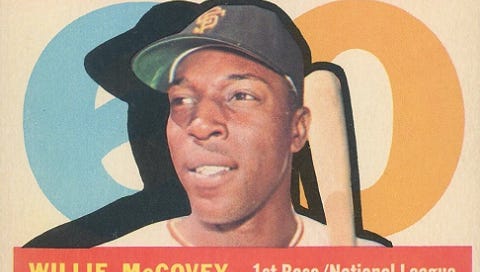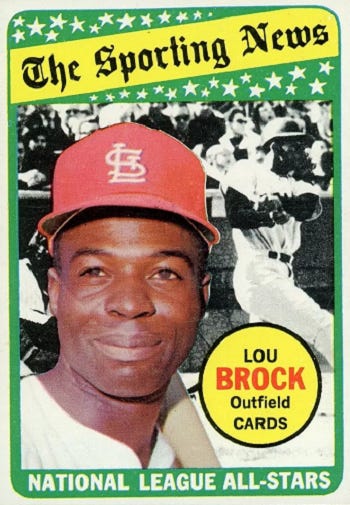Don’t know about you, but I’m feeling a bit Rip(ken) Van Winkle with regard to the current baseball season. I mean, here I was just last night dreaming about Spring Training, and then I wake up to find the last Sunday in May?!?
Hmmmph.
The good news about that, of course, is that these are baseball’s golden days, with nothing but hot weather, summer holidays, and full schedules ahead of us.
And the All-Star break, of course, up there over the June-July horizon.
Oh, and today specifically, Bob Knepper’s 71st birthday.
How do any of these tie together? Well, I’ll let you figure that out, with the help of these five baseball cards
1960 Topps Willie McCovey All-Star (#554)
Willie McCovey didn’t debut with the Giants until July 30, 1959. Even with that late start, though, he managed to hit .354 with 13 home runs and 38 RBI in just 52 games. That was enough to make him a unanimous choice as the National League Rookie of the Year…and for Topps to Stretch their 1960 checklist enough to include two Big Mac cards.
Card #316 was McCovey’s “All-Star Rookie” card, otherwise known as his rookie card.
Card #554 was McCovey’s entry in the Sport Magazine All-Star subset (cards #553-572).
Now, for the average collector (or at least this collector) who comes across an All-Star card, a reasonable knee-jerk thought might be that the player in question was, like, an All-Star the year before the card was issued. Maybe even the same year.
But, of course, McCovey’s late-July arrival in the big leagues meant he couldn’t have played in the first 1959 All-Star Game, held on July 7. The second All-Star Game, played on August 3, was at least a technical possibility…by McCovey wasn’t there.
And, as it turned out, he wasn’t an All-Star in 1960, either.
Sport apparently thought he would be, though, or at least that he deserved an extra accolade. Topps didn’t argue, and collectors have been the main beneficiaries of those decisions for 65 years.
1969 Topps Lou Brock All-Star (#428)
By 1969, Lou Brock was a bona fide superstar after helping the Cardinals win two pennants and a World Series since his arrival in 1964. And the swap that brought him (and others) to St. Louis from the Cubs in exchange for Ernie Broglio (and others) was already looking like it would end up one of the lopsided deals of all time.
That was partially because the early part of his run (ahem) with the Cardinals also brought some All-Star dalliances.
In 1967, Brock was hitting in the .320s in mid-June and heading toward his second straight stolen base title — good enough to land the midsummer gig as the National League’s starting left fielder in the All-Star Game. For his troubles, he also landed a 1968 Topps All-Star card.
In 1968, though, Brock did not make the All-Star cut, with LF going to Cardinals teammate, center fielder Curt Flood. Brock was absent from the Midsummer Classic in 1969, too, with Mets standout Cleon Jones nabbing the left field spot.
But even though he missed out on the real All-Star Games in both ‘68 and ‘69, Brock made the cut in the eyes of The Sporting News…and Topps, at least in 1969.
In case you were wondering, Brock finally made it back to the ASG in 1971, then repeated four more times through the end of his career in 1979
1974 Topps All-Star First Basemen (#332)
This one comes with a bit of an asterisk, but it’s worth that extra mental keystroke to loop in some baseball history.
The All-Star Game starters in 1973 were chosen through the fan vote, as in most years, and Allen won the nod at first base for the American League. But a broken leg suffered in June made that assignment impossible, so Royals youngster John Mayberry took his spot. A fitting choice given that the ASG was held at Royals Stadium that summer.
In the National League, Aaron was elected the starter at first, a departure from his normal outfield slot. It seems all the stranger when you dig into Hammer’s stats and realize that he played no games at first base — other than the All-Star Game — in 1973, but had spent most of his time at first in 1972.
Topps chose to feature the top vote-getters on their 1974 All-Star cards, so this first base number gives us…
A man who wasn’t in the 1973 All-Star Game at all, and who was with a different team in a different league by the time the card was issued.
A legendary slugger at an unfamiliar position, one he would never again play in the majors by the time the card was issued.
Two future Hall of Famers with enough baseball history to fill a shelf-full of books.
1985 Topps All-Star Bob Knepper (#721)
Bob Knepper made his first All-Star appearance in 1981, his first season with the Astros after the trade that sent Enos Cabell from Houston to the Giants. During that strike-torn summer, Knepper went 9-5 with a sparkly 2.18 ERA. He also tossed two scoreless frames in the Midsummer Classic in Cleveland.
Knepper followed up with a couple of rocky seasons, but he was on his game in 1984, going 15-10 with a 3.20 ERA while making 34 starts in 35 total appearances. He won 15 and 17 games the next two seasons, the latter helping the Astros win their second full-season division title.
Even with that mound success, though, Knepper didn’t make it back to the All-Star Game until 1988, when he went 14-5 with a 3.14 ERA, including 9-2, 2.43 before the break.
Maybe Topps had an eye on the past or had their crystal ball tuned up and humming at peak clarity, or maybe they just marched to the tune of their own All-Star drummer. Whatever the case, Knepper made the 1985 Topps cut…and a chance to drive our weekly ramblings all these years later.
1989 Topps Kirk Gibson All-Star (#396)
It’s still shocking to crack open Kirk Gibson’s page on Baseball Reference (or your record-book simulator of choice) and be reminded that he never made an All-Star Game.
But as with the Dick Allen card above, there’s a backstory to the Gibby-Midsummer saga.
While it’s true Gibson was never elected to start an All-Star Game, he was invited by his league’s manager to participate as a reserve on two occasions — in 1985 and in 1988. In both cases, he declined the invite and instead turned his focus to getting ready for the second half.
(As an aside on this point, that first invite came from Gibson’s own Tigers manager, Sparky Anderson.)
But when it came time to fill out the lineup for their 1989 All-Star subset, Topps apparently couldn’t bring themselves to overlook the 1988 World Series hero and National League Most Valuable Player. Fittingly (given his Fall Classic role), Topps bills him as a pinch hitter on this card.
—
This is at least the second time I’ve taken on All-Stars that weren’t, with this old article throwing out the first pitch. A couple of cards above appear among those 11 entries, but there are some “new” ones for your consideration, too.
So…
What’s your favorite not-an-All-Star All-Star card? Love to hear your picks!
Thanks for reading.
—Adam









I know this was about All-Star appearances, but as a lifelong Redbirds fan from St. Louis, I gotta call out that Lou Brock postseason history. Using the form in which it was written, Brock actually helped the Cardinals claim 2 World Series victories (1964,1967) and a pennant (1968). Although if we're being technical (I know you love that stuff), It's actually 3 National League pennants and 2 World Series. Because you can't win the series without winning the pennant first. Have a great one, Adam. Fun stuff as always!
Great stuff. 1988 Topps AS of Dwight Gooden. I guess Topps was surprised or didn’t want to make one of Sid Fernandez that year. This article makes me think of Freddie Patek who should’ve had the AS designation on his card in 1979 but didn’t and never made another AS game.